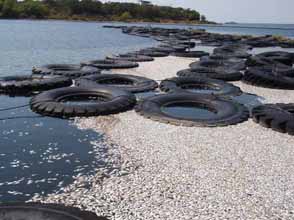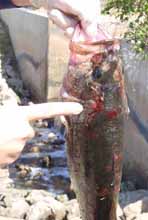Call our 24-Hour Communication Center (512) 389-4848 - Austin
Kills and Spills Team
Determine the Cause of Kills and Pollution Incidents
A primary responsibility of the Kills and Spills Team is to investigate fish and wildlife kills and pollution events. When a kill is reported, KAST biologists get busy collecting evidence to determine what went wrong. The sources of fish and wildlife kills can be divided into two broad categories: natural causes and human activities.
Natural

Fish kill at Grapevine Lake
The most common cause of fish kills in Texas is low dissolved oxygen. If there isn't enough oxygen in the water, fish can't "breathe." Low dissolved oxygen can be the result of human activities, but in many cases it's a natural occurrence.
Daily variations in dissolved oxygen concentration are attributed to photosynthesis and aerobic respiration. Increased dissolved oxygen during the day is a result of photosynthesis which is driven by sunlight. Photosynthesis stops at night and may slow down on cloudy days, but plants and animals in the water continue to respire and consume free oxygen, decreasing the dissolved oxygen concentration. Often before a kill event occurs, fish can be seen trying to get oxygen by gulping at the surface of the water early in the morning. Some fish may also be lying on the bottom or at the edge of the water.

Largemouth bass showing signs of infection
Other natural causes of fish kills include extreme weather (hot and cold), bacterial and viral diseases, and parasitic infections. In some cases algae blooms produce toxins that lead to fish kills. Visit our Harmful Algal Blooms section to learn more about golden alga, red tide, and cyanobacteria.
Extreme weather and harmful algal blooms tend to affect all species present. Bacterial, viral, or parasitic infections typically affect only a single species.
Human Activities
Human activities that can cause fish or wildlife kills include toxic releases of chemicals, pesticides, fertilizers, crude oil, used oil, oilfield brine, sewage, and chlorinated water. Habitat alterations such as dam maintenance, the creation of dead-end canals, and the channelization of streams and stormwater conveyances can all lead to impacts on natural resources, including fish and wildlife kills.